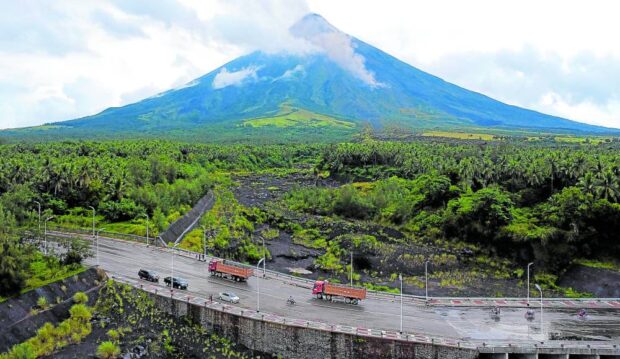Heavy rains cause ‘data gaps’ in Mayon observatory

LAHAR PATH | Villages in areas identified as high-risk for lahar from Mayon Volcano are advised to be ready, especially during the typhoon season as heavy and continuous rains may generate lahar flows along major channels. This image of Mayon was taken from Barangay Mabinit in Legazpi City on July 21, 2023. (File photo by MARK ALVIC ESPLANA / Inquirer Southern Luzon)
LEGAZPI CITY, Albay, Philippines — Heavy rains that affected Albay province in the past few days caused equipment to discharge, leading to possible “data gaps,” or inaccurate record of volcanic activity on Mayon Volcano.
Paul Karson Alanis, resident volcanologist of the Philippine Institute of Volcanology and Seismology (Phivolcs) Legazpi, said in a private message Wednesday that from July 26 to July 30, the detection of pyroclastic density currents (PDCs, or fast-moving mixture of ash, gases, and volcanic debris) and rockfall had been affected by the powering down of the solar-powered Anoling, Camalig Observation Station (VMAN) as it has not been recharged for days.
The VMAN is inside the 6-kilometer-radius permanent danger zone (PDZ) and the closest station to the Mi-isi and Bonga gullies of the volcano.
“It was not damaged, likely the battery became empty due to constant rains lately,” Alanis said on Wednesday.
He said it was possible that their instruments missed recording some volcanic events due to this problem.
Article continues after this advertisementIn the Phivolcs bulletins issued from July 27 to July 30, only the low-frequency volcanic earthquakes (LFVQs) and rockfall events were monitored.
Article continues after this advertisementWhen the instrument became fully functional again on July 31, Phivolcs recorded phases of intermittent ashing with 100-meter gray ash plumes at the northeast portion of the volcano.
Its Aug. 1 bulletin showed that 258 volcanic earthquakes, including one tremor event with a duration of a minute and 30 seconds; 256 LFVQs; 57 ashing events; and 100 rockfall events were recorded by the Mayon Volcano Network.
Phivolcs, in its Aug. 2 bulletin, said 57 LFVQs, five PDCs, 225 rockfall events and four ashing events were recorded.
Ashfall, lahar alerts
Phivolcs said that with the prevailing wind pattern, ashfall may most likely occur on the south side of the volcano, facing Legazpi City, and towns of Daraga and Camalig.
Tim Lawrence Florece, information officer of Camalig town, said no ashfall was noted in the town but residents near the slopes and river channels had to be on alert for possible lahar flow during heavy rains.
“The disaster management officials conducted lahar preparedness information drive in the high-risk villages,” Florece said on Wednesday.
All residents inside the danger zone of the volcano were already evacuated in the said town.
As of Tuesday, 5,813 families (20,331 people) were still in evacuation sites in the cities of Ligao, and Tabaco, and the towns of Daraga, Camalig, Guinobatan, Malilipot, and Sto. Domingo.
Alert level 3 still prevails over Mayon Volcano, which indicates the possibility of a hazardous eruption within weeks or even days. The alert has been up since June 8.
RELATED STORIES:
Phivolcs: Mayon Volcano quakes decline, rockfall events up
Mayon Volcano logs 248 quakes, and 112 rockfall events in last 24 hrs – Phivolcs